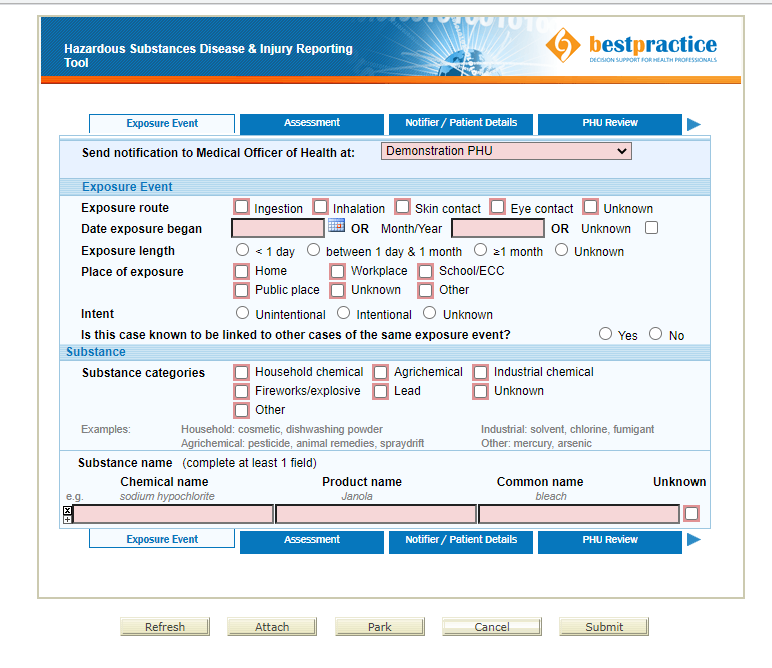Resources for health professionals
We have developed a tool to help health professionals report hazardous substances injuries and diseases.
The HSDIRT tool (Hazardous Substances Disease and Injury Reporting Tool) is a GP-based system for reporting hazardous substances injuries and diseases.
This section provides a range of resources about hazardous substances, and the HSDIRT.
These resources will be useful for all medical professionals, including GPs and other primary care health professionals, and the injury prevention sector.
On this page:
Information about HSDIRT for health professionals
If you are a healthcare professional, you need to use the HSDIRT tool to report injuries and diseases that you suspect are caused by a hazardous substance.
HSDIRT training materials are available to health care professionals and Public Health Unit staff who investigate hazardous substance-related complaints.
You can find useful information about HSDIRT for GPs and Public Health Units (PHUs) below. These resources may be useful in the investigation of a notification, or deciding whether a notification needs to occur. There are some health education resources that would be useful for patients.
GP Information |
PHU Information |
| Users Guide for GPs (short version) | Frequently Asked Questions |
| Users Guide for GPs | Users Guide for PHUs |
| Legislation | HSDIRT blank form |
What the HSDIRT tool looks like
Figure 1 shows a screenshot of the HSDIRT tool, used when reporting injuries and diseases that are suspected to be caused by a hazardous substance.
Figure 1: Screenshot of HSDIRT (Hazardous Substances Disease and Injury Reporting Tool)

HSDIRT logins
Recently, we have worked with BPAC to improve the cyber-security of the HSDIRT system. From now on, Each of the Public Health units must have their own username and password to access the HSDIRT tool. If you haven't had your individual HSDIRT account yet, please contact us.
Articles on hazardous substances
We have worked with bestpractice to develop a series of expert-author articles on a range of hazardous substances topics. These are suited to a primary care audience.
Accelerated silicosis: diagnosis of an occupational disease
Publication: Best Practice Journal, December 2023
Childhood poisonings: Hazardous substances around the home
Publication: Best Practice Journal, November 2022
Lead absorption notification levels have reduced
Publication: Best Practice Journal, June 2021
Consider blue-green algal blooms this summer: Identifying and managing suspected cyanotoxin poisoning in primary care
Publication: Best Practice Journal, November 2020
Carbon monoxide poisoning: a hidden danger
Publication: Best Practice Journal, October 2019
Laboratory investigation of exposure to metals or other hazardous substances in the environment
Publication: Best Tests, November 2013
Lead author: Stephen du Toit
Pyrethroid toxicity and its management
Publication: Best Practice Journal, December 2013
Lead authors: Dr Michael Beasley and Dr Wayne Temple
Assessing and managing workplace exposure to chemicals
Publication: Best Tests, February 2014
Lead author: Dr Chris Walls (Occupational physican, Auckland)
Hazardous substances poisoning in children
Publication: Best Practice Journal, March 2014
Lead authors: Dr Mike Shepherd and Dr Stu Dalziel, Emergency Medicine, Starship Children’s Hospital)
Contact dermatitis: a ‘working’ diagnosis
Publication: Best Practice Journal, April 2014
Lead author: Dr Lissa Judd (occupational dermatologist, Wellington)
Articles on the Hazardous Substances Disease and Injury Reporting Tool (HSDIRT)
For all medical professionals
Lead absorption notification levels have reduced
Health professionals should be aware of the new notifiable level (0.24 micromol/L) and be familiar with the electronic reporting via the Hazardous Substances Disease and Injury Reporting Tool (HSDIRT).
![]() HSDIRT flyer
HSDIRT flyer
A flyer with a general reminder about HSDIRT notifications. The flyer is intended for primary care use, and is suitable as a small ‘poster’ within consulting rooms. For printed copies, contact us.
New Zealand Public Health Surveillance Report (published by ESR)- December 2013, page 4-5
An article highlighting that all doctors must notify a Medical Officer of Health about disease and injury caused by hazardous substances. It includes a description of the HSDIRT notification system for primary care, and examples of hazardous substances. This article is aimed at public health professionals and all primary care doctors.
Prescriber Update (published by MedSafe)- December 2013, page 45
An article aimed at all doctors in New Zealand. It highlights that all doctors must notify a Medical Officer of Health about disease and injury caused by hazardous substances. Hazardous substances are defined, and the article describes how to notify a case.
For the injury prevention sector
SafeKids News- December 2013, page 8
An article providing data on the causes of hazardous substances injuries in hospitalised children from 2006-2011. It introduces HSDIRT, and explains how it aims to fill a gap in hazardous substances surveillance. It explains how the data will be used.
For questions relating to the Hazardous Substances Surveillance System (HSSS), please contact Helene Marsters.
Phone: +64 4979 3382
Email: t.h.marsters@massey.ac.nz
